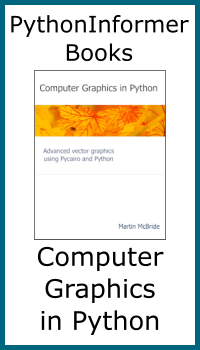Path objects in generativepy
Categories: generativepy generativepy tutorial

This tutorial covers the basics of using Path objects in generativepy.
You can think of a Path as being an abstract shape:
- You can create a
Pathobject in the same way as you would draw a shape, but creating thePathdoesn't draw anything. - You can then draw the path as many times as you want, using
filland/orstroke. - You can also create a clipping region using the path.
You can draw the same path in different ways (eg different fill or stroke styles), in different positions, or even scaled and rotated.
Path example code
Here is a sample Python program for creating various filled and outlined rectangles. The code is explained later in this article:
from generativepy.drawing import make_image, setup
from generativepy.color import Color
from generativepy.geometry import Polygon, Text, Path, Transform
'''
Demonstrate paths in the geometry module.
'''
def draw(ctx, width, height, frame_no, frame_count):
setup(ctx, width, height, width=5, background=Color(0.8))
# Get a polygon path object
path1 = Polygon(ctx).of_points([(0, 0), (1, 1), (0.5, 2), (0.5, 1)])\
.path()
# Get a text path object
path2 = Text(ctx).of("Path text", (0, 0)).font("Times").size(0.2)\
.align_left().align_top().path()
# Apply the polygon in various places
with Transform(ctx).translate(0.5, 1):
Path(ctx).of(path1).stroke(Color('darkgreen'), 0.1)
with Transform(ctx).translate(1, 2.5):
Path(ctx).of(path1).fill(Color('blue'))
with Transform(ctx).translate(2.5, 0.5).scale(2, 2):
Path(ctx).of(path1).fill(Color('orange')).stroke(Color('black'), 0.05)
# Apply the text in various places
with Transform(ctx).translate(0, 0):
Path(ctx).of(path2).fill(Color('black'))
with Transform(ctx).translate(2, 3):
Path(ctx).of(path2).stroke(Color('red'), 0.01)
with Transform(ctx).translate(2, 4).scale(2, 2):
Path(ctx).of(path2).fill(Color('yellow')).stroke(Color('black'), 0.01)
make_image("path.png", draw, 500, 500)
This code is available on github in tutorial/shapes/path.py.
Here is the resulting image:

Creating the paths
The first part of the code creates a couple of paths. Here is the first:
path1 = Polygon(ctx).of_points([(0, 0), (1, 1), (0.5, 2), (0.5, 1)])\
.path()
In this case, we have created a Polygon in the usual way, but instead of filling or stroking the shape, we call path. This returns a Pycario path object. You can think of the path object as being like a set of instructions for drawing the shape.
This code doesn't draw anything, it just saves the drawing instructions in path1.
Here is the second path:
path2 = Text(ctx).of("Path text", (0, 0)).font("Times").size(0.2)\
.align_left().align_top().path()
This time we have created a complex path - some text. But the result is the same, we don't draw anything but the instructions for drawing the text are stored in path2.
Drawing path1
Here is the code that actually draws path1
with Transform(ctx).translate(0.5, 1):
Path(ctx).of(path1).stroke(Color('darkgreen'), 0.1)
with Transform(ctx).translate(1, 2.5):
Path(ctx).of(path1).fill(Color('blue'))
with Transform(ctx).translate(2.5, 0.5).scale(2, 2):
Path(ctx).of(path1).fill(Color('orange')).stroke(Color('black'), 0.05)
In the first line, we use a Transform object to moves user space by (0.5, 1).
We then use a Path object. This takes the drawing instructions in path1 and adds them to the context ready to be drawn. We then stroke the shape in dark green. If you look at the definition of the polygon that is used to define path1, you will see that the top left corner of the polygon is at (0, 0), but because we have translated user space, the polygon actually gets drawn at (0.5, 1).
The second block draws the same shape again, this time at (1, 2.5), and it fills it rather than outlining it.
The third block draws the shape yet again, this time at (2.5, 0.5). In this case, we also scale userspace by (2, 2), which scales user space in the x and y directions. We fill and outline the shape, and because of the scaling, the shape appears twice as big.
Drawing path2
Here is the code that draws path2
with Transform(ctx).translate(0, 0):
Path(ctx).of(path2).fill(Color('black'))
with Transform(ctx).translate(2, 3):
Path(ctx).of(path2).stroke(Color('red'), 0.01)
with Transform(ctx).translate(2, 4).scale(2, 2):
Path(ctx).of(path2).fill(Color('yellow')).stroke(Color('black'), 0.01)
This illustrates the use of complex paths. We draw the same text path filled, stroked, and also scaled, filled and stroked.
Related articles
- Polygons in generativepy
- Regular polygons in generativepy
- Circles and ellipses in generativepy
- Bezier curves in generativepy
- Fill and stroke in generativepy
- Stroke styles in generativepy
- Fill styles in generativepy
- Text in generativepy
- Text offset in generativepy
- Text metrics in generativepy
- Composite paths in generativepy
- Complex paths in generativepy
- Images in generativepy
- Geometric markers in generativepy
- Turtles in generativepy
Join the GraphicMaths/PythonInformer Newsletter
Sign up using this form to receive an email when new content is added to the graphpicmaths or pythoninformer websites:
Popular tags
2d arrays abstract data type and angle animation arc array arrays bar chart bar style behavioural pattern bezier curve built-in function callable object chain circle classes close closure cmyk colour combinations comparison operator context context manager conversion count creational pattern data science data types decorator design pattern device space dictionary drawing duck typing efficiency ellipse else encryption enumerate fill filter for loop formula function function composition function plot functools game development generativepy tutorial generator geometry gif global variable greyscale higher order function hsl html image image processing imagesurface immutable object in operator index inner function input installing integer iter iterable iterator itertools join l system lambda function latex len lerp line line plot line style linear gradient linspace list list comprehension logical operator lru_cache magic method mandelbrot mandelbrot set map marker style matplotlib monad mutability named parameter numeric python numpy object open operator optimisation optional parameter or pandas path pattern permutations pie chart pil pillow polygon pong positional parameter print product programming paradigms programming techniques pure function python standard library range recipes rectangle recursion regular polygon repeat rgb rotation roundrect scaling scatter plot scipy sector segment sequence setup shape singleton slicing sound spirograph sprite square str stream string stroke structural pattern symmetric encryption template tex text tinkerbell fractal transform translation transparency triangle truthy value tuple turtle unpacking user space vectorisation webserver website while loop zip zip_longest
